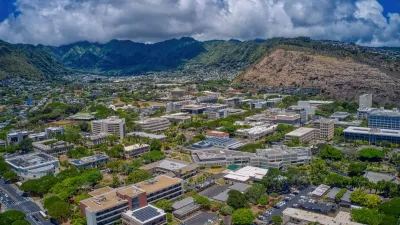The rise of the innovation economy is driving fierce competition between cities across America to attract medical facilities and universities as job providers and engines of development.
The role of the medical industry and higher education in stimulating development, and boosting employment, is the focus of reporting by Urban Land Magazine's Mike Sheridan. As America moves from a manufacturing economy to a knowledge economy, medical facilities and universities are leading the diversification of metropolitan economies across the country.
"Among the 100 largest cities in the country, two-thirds have medical facilities and universities as major employers, [Tom Murphy, ULI senior resident fellow, and former mayor of Pittsburgh] notes. 'Over the last 20 years, we've watched a real turnaround in cities that historically were manufacturing based, and over the years it's all changed,' he says. 'Medicine and education have become economic generators in cities including Baltimore, Boston, and a number of others. It speaks [volumes] about the loss of manufacturing jobs and also about the increasing impact of medical facilities, which are not only providing care and education, but also becoming major research centers with a major economic impact.'"
In post-recession Florida, Orlando is looking to Lake Nona Medical City to provide jobs and economic development. With partners such as the University of Florida, Nemours pediatric health care system, and U.S. Department of Veterans Affairs, Lake Nona's Medical City campus is expected to provide thousands of new jobs and generate billions of dollars in construction spending.
Understanding the growing importance of such facilities, cities across America are offering lucrative incentives and building infrastructure to lure colleges and medical cluster anchors. "Communities-and developers-seeking to attract medical clusters should be patient and listen to others who have been through the process, says [Larry Pelton, president of the Economic Development Council of St. Lucie County]. 'They should build infrastructure that is attractive to scientists and to the institutes, including housing, education, and recreation facilities, a vibrant vendor/supplier network, and a leadership team that is 100 percent committed to success,' he advises."
Thanks to Andrew Gorden
FULL STORY: Innovation Anchors: Medical and Educational Facilities Drive Development

Study: Maui’s Plan to Convert Vacation Rentals to Long-Term Housing Could Cause Nearly $1 Billion Economic Loss
The plan would reduce visitor accommodation by 25,% resulting in 1,900 jobs lost.

North Texas Transit Leaders Tout Benefits of TOD for Growing Region
At a summit focused on transit-oriented development, policymakers discussed how North Texas’ expanded light rail system can serve as a tool for economic growth.

Why Should We Subsidize Public Transportation?
Many public transit agencies face financial stress due to rising costs, declining fare revenue, and declining subsidies. Transit advocates must provide a strong business case for increasing public transit funding.

Dear Tesla Driver: “It’s not You, It’s Him.”
Amidst a booming bumper sticker industry, one writer offers solace to those asking, “Does this car make me look fascist?”

A Visual Celebration of Manhattan’s Chinatown Elder Community, Through Food
Lanterns, cafeteria trays, and community connection take center stage in this stunning photo essay.

How to Make US Trains Faster
Changes to boarding platforms and a switch to electric trains could improve U.S. passenger rail service without the added cost of high-speed rail.
Urban Design for Planners 1: Software Tools
This six-course series explores essential urban design concepts using open source software and equips planners with the tools they need to participate fully in the urban design process.
Planning for Universal Design
Learn the tools for implementing Universal Design in planning regulations.
City of Santa Clarita
Ascent Environmental
Institute for Housing and Urban Development Studies (IHS)
City of Grandview
Harvard GSD Executive Education
Toledo-Lucas County Plan Commissions
Salt Lake City
NYU Wagner Graduate School of Public Service




























